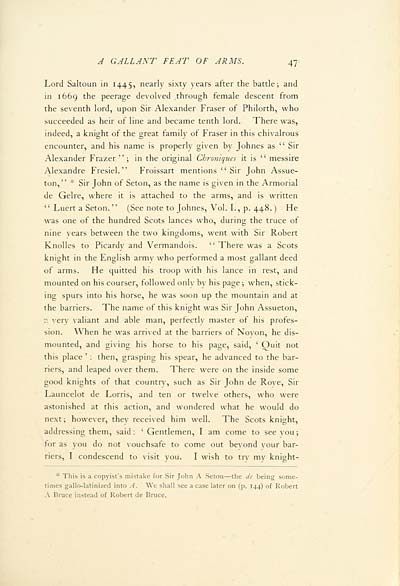Old family; or, The Setons of Scotland and America
(83) Page 47
Download files
Complete book:
Individual page:
Thumbnail gallery: Grid view | List view

A GALLANT FEAT OF ARMS. 47
Lord Saltoun in 1445, nearly sixty years after the battle; and
in 1669 the peerage devolved through female descent from
the seventh lord, upon Sir Alexander Fraser of Philorth, who
succeeded as heir of line and became tenth lord. There was,
indeed, a knight of the great family of Fraser in this chivalrous
encounter, and his name is properly given by Johnes as " Sir
Alexander Frazer " ; in the original Cbroniques it is " messire
Alexandre Fresiel." Froissart mentions "Sir John Assue-
ton," * Sir John of Seton, as the name is given in the Armorial
de Gelre, where it is attached to the arms, and is written
" Luert a Seton. " (See note to Johnes, Vol. I., p. 448. ) He
was one of the hundred Scots lances who, during the truce of
nine years between the two kingdoms, went with Sir Robert
Knolles to Picardy and Vermandois. "There was a Scots
knight in the English army who performed a most gallant deed
of arms. He quitted his troop with his lance in rest, and
mounted on his courser, followed only by his page ; when, stick-
ing spurs into his horse, he was soon up the mountain and at
the barriers. The name of this knight was Sir John Assueton,
a very valiant and able man, perfectly master of his profes-
sion. When he was arrived at the barriers of Noyon, he dis-
mounted, and giving his horse to his page, said, ' Quit not
this place ' : then, grasping his spear, he advanced to the bar-
riers, and leaped over them. There were on the inside some
good knights of that country, such as Sir John de Roye, Sir
Launcelot de Lorris, and ten or twelve others, who were
astonished at this action, and wondered what he would do
next; however, they received him well. The Scots knight,
addressing them, said: ' Gentlemen, I am come to see you;
for as you do not vouchsafe to come out beyond your bar-
riers, I condescend to visit you. I wish to try my knight-
* This is a copyist's mistake for Sir John A Seton — the de being some-
times gallo-latinized into A. We shall see a case later on (p. 144) of Robert
A Bruce instead of Robert de Bruce.
Lord Saltoun in 1445, nearly sixty years after the battle; and
in 1669 the peerage devolved through female descent from
the seventh lord, upon Sir Alexander Fraser of Philorth, who
succeeded as heir of line and became tenth lord. There was,
indeed, a knight of the great family of Fraser in this chivalrous
encounter, and his name is properly given by Johnes as " Sir
Alexander Frazer " ; in the original Cbroniques it is " messire
Alexandre Fresiel." Froissart mentions "Sir John Assue-
ton," * Sir John of Seton, as the name is given in the Armorial
de Gelre, where it is attached to the arms, and is written
" Luert a Seton. " (See note to Johnes, Vol. I., p. 448. ) He
was one of the hundred Scots lances who, during the truce of
nine years between the two kingdoms, went with Sir Robert
Knolles to Picardy and Vermandois. "There was a Scots
knight in the English army who performed a most gallant deed
of arms. He quitted his troop with his lance in rest, and
mounted on his courser, followed only by his page ; when, stick-
ing spurs into his horse, he was soon up the mountain and at
the barriers. The name of this knight was Sir John Assueton,
a very valiant and able man, perfectly master of his profes-
sion. When he was arrived at the barriers of Noyon, he dis-
mounted, and giving his horse to his page, said, ' Quit not
this place ' : then, grasping his spear, he advanced to the bar-
riers, and leaped over them. There were on the inside some
good knights of that country, such as Sir John de Roye, Sir
Launcelot de Lorris, and ten or twelve others, who were
astonished at this action, and wondered what he would do
next; however, they received him well. The Scots knight,
addressing them, said: ' Gentlemen, I am come to see you;
for as you do not vouchsafe to come out beyond your bar-
riers, I condescend to visit you. I wish to try my knight-
* This is a copyist's mistake for Sir John A Seton — the de being some-
times gallo-latinized into A. We shall see a case later on (p. 144) of Robert
A Bruce instead of Robert de Bruce.
Set display mode to:
![]() Universal Viewer |
Universal Viewer | ![]() Mirador |
Large image | Transcription
Mirador |
Large image | Transcription
Images and transcriptions on this page, including medium image downloads, may be used under the Creative Commons Attribution 4.0 International Licence unless otherwise stated. ![]()
| Histories of Scottish families > Old family; or, The Setons of Scotland and America > (83) Page 47 |
|---|
| Permanent URL | https://digital.nls.uk/95730915 |
|---|
| Description | A selection of almost 400 printed items relating to the history of Scottish families, mostly dating from the 19th and early 20th centuries. Includes memoirs, genealogies and clan histories, with a few produced by emigrant families. The earliest family history goes back to AD 916. |
|---|

